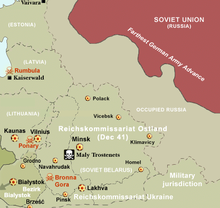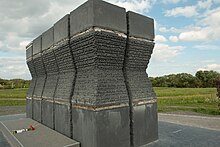Maly Trostenets

Maly Trostenets (Maly Trascianiec, Belarusian: Малы Трасцянец, "Little Trostenets") is a village near Minsk in Belarus, formerly the Byelorussian Soviet Socialist Republic. During Nazi Germany's occupation of the area during World War II (when the Germans referred to it as Reichskommissariat Ostland), the village became the location of a Nazi extermination site.[1]
Throughout 1942, Jews from Austria, Germany, the Netherlands, Poland, and the Protectorate of Bohemia and Moravia were taken by train to Maly Trostinets to be lined up in front of the pits and were shot.[1] From the summer of 1942, mobile gas vans were also used.[2][3] According to Yad Vashem, the Jews of Minsk were killed and buried in Maly Trostinets and in another village, , between 28 and 31 July 1942 and on 21 October 1943.[1] As the Red Army approached the area in June 1944, the Germans killed most of the prisoners and destroyed the camp.[1]
The estimates of how many people died at Maly Trostinets vary. According to Yad Vashem, 65,000 Jews were murdered in one of the nearby pine forests, mostly by shooting.[3] Holocaust historian Stephan Lehnstaedt believes the number is higher, writing that at least 106,000 Jews died at the location. Researchers from the Soviet Union estimated there had been around 200,000 deaths at the camp and nearby execution sites. Lehnstaedt writes that the estimates include the Jews of the Minsk Ghetto, who numbered 39,000 to almost 100,000.[4][a]
Camp establishment and destruction[]

Built in the summer of 1941 on the site of a Soviet kolkhoz, a collective farm 200 hectares (490 acres) in size, Trostinets was set up by Nazi Germany as a concentration camp with no fixed killing facilities. It was originally established for Soviet prisoners of war captured during the invasion of the Soviet Union, which began on 22 June 1941.[citation needed]
Jews from Austria, Germany and the Czech Republic were murdered there. Holocaust transports organized by the SS were sent from Berlin, Hanover, Dortmund, Münster, Düsseldorf, Cologne, Frankfurt am Main, Kassel, Stuttgart, Nuremberg, Munich, Breslau, Königsberg, Vienna, Prague, Brünn, and Theresienstadt. In most cases, the Jews were killed on arrival. They were trucked from the train stop to the Blagovshchina (Благовщина) and Shashkovka (Шашковка) forests and shot in the back of the neck.[citation needed]
The primary purpose of the camp was the killing of Jewish prisoners of the Minsk Ghetto and the surrounding area. Firing squad was the chief execution method. Mobile gas vans were also deployed. Baltic German SS-Scharführer Heinrich Eiche was the camp administrator.[6][need quotation to verify] As the Red Army approached the camp in June 1944,[7] toward the end of World War II, between June 28 and June 30, the Germans murdered the majority of prisoners by locking them inside of the camps, burning their barracks, and when anyone tried to escape the burning building they were shot.[8][9][10] By June 30 the entire camp had been destroyed, however, a few Jewish prisoners were able to escape into the surrounding Blagovshchina forest and survive until July 3 when the approaching Red Army reached the decimated camp.[8][9][10]
The Soviets are said to have discovered 34 grave-pits, some of them measuring as much as 50 meters (160 ft) in length and three to four meters (9.8–13 ft) in depth, located in the Blagovshchina Forest some 500 meters (1,600 ft) from the Minsk–Mogilev highway, according to the special report prepared by the Soviet Extraordinary State Commission in the 1940s.[citation needed] A great number of Soviet soldiers, citizens and partisans were killed, but the exact number remains unknown. Estimates range from 80,000 to more than 330,000.[1][failed verification]
After the war[]


Perpetrators[]
Few of the perpetrators were brought to justice. Among them was Eduard Strauch, who died in a Belgian prison in 1955. In 1968 a court in Hamburg sentenced three low-ranking SS men to life imprisonment: Rottenführer Otto Erich Drews, Revieroberleutnant Otto Hugo Goldapp, and Hauptsturmführer Max Hermann Richard Krahner. The men were German overseers of the Jewish Sonderkommando 1005; they were found guilty of murdering laborers forced to cover up the traces of the crimes in 1943.[citation needed]
Victims[]
The names of 10,000 Austrian Jews murdered in Maly Trostinec were collected in a book, Maly Trostinec – Das Totenbuch: Den Toten ihre Namen, by Waltraud Barton.[11]
- Cora Berliner (most likely)[citation needed]
- Grete Forst[citation needed]
- Arthur Ernst Rutra, author and translator
- Vincent Hadleŭski [Wincenty Godlewski], Roman Catholic priest and Belarusian nationalist resistance fighter (b. 1888), arrested in Minsk on 24 December 1942 and shot at Trostinets the same day.[citation needed]
- Margarete Hilferding (in transit to the camp from Terezín)[citation needed]
- Norbert Jokl (debated)[citation needed]
Memorial[]
A memorial built at the site of the camp attracts thousands of visitors annually, especially after travel restrictions eased with the dissolution of the Soviet Union.[citation needed]

Memorial sign on the place of main massacres

The plate of the planned memorial complex

Memorial complex, built in 2015
See also[]
Notes[]
References[]
- ^ Jump up to: a b c d e "Maly Trostinets" (PDF). Yad Vashem. Archived (PDF) from the original on 29 November 2003.
- ^ Heberer, Patricia (2008). "Justice in Austrian Courts? The Case of Josef W. and Austria's Difficult Relationship with Its Past". In Heberer, Patricia; Matthäus, Jürgen (eds.). Atrocities on Trial: Historical Perspectives on the Politics of Prosecuting War Crimes. Lincoln and London: University of Nebraska Press. p. 131.
- ^ Jump up to: a b "Maly Trostenets, Camp, Belorussia (USSR)". The International Institute for Holocaust Research, Yad Vashem. Archived from the original on 5 June 2019.
- ^ Lehnstaedt, Stephan (2016) [2010]. Occupation in the East: The Daily Lives of German Occupiers in Warsaw and Minsk, 1939–1944. New York and Oxford: Berghahn Books. p. 30. ISBN 978-1-78533-323-1.
- ^ Smilovitsky, Leonid (Summer–Winter 1999). "Ilya Ehrenburg on the Holocaust in Belarus: Unknown Testimony". East European Jewish Affairs. 29 (1–2): 61–74. Archived from the original on 14 December 2002.
- ^ Kohl, Paul (2003). Das Vernichtungslager Trostenez: Augenzeugenberichte und Dokumente. Internationales Bildungs- und Begegnungswerk IBB. pp. 102–111.
- ^ "Contraction Camps: Maly Trostiets". Jewish Virtual Library. Retrieved 2019-11-25.
- ^ Jump up to: a b "Maly Trostinets The Death Camp near Minsk". Holocaust Education & Archive Research Team. Retrieved 2019-11-25.
- ^ Jump up to: a b "Maly Trostinets Camp". Holocaust Historical Society. Holocaust Historical Society. Retrieved 2019-11-25.
- ^ Jump up to: a b "Maly Trostinets". Aktion Reinhard Camps. Retrieved 2019-11-25.
- ^ "Book presentation: Maly Trostinec – das Totenbuch: Den Toten ihre Namen geben". Jewish Museum Vienna. 1 October 2015.
Further reading[]
| Wikimedia Commons has media related to Trascianiec extermination camp. |
- Kohl, Paul (1995). Der Krieg der deutschen Wehrmacht und der Polizei, 1941–1944: sowjetische Überlebende berichten. Frankfurt am Main: Fischer-Taschenbuch-Verlag (includes a photograph of the camp).
- Spector, Shmuel (1990). "Aktion 1005 – Effacing the Murder of Millions". Holocaust and Genocide Studies. 5 (2): 157–173. doi:10.1093/hgs/5.2.157.
Coordinates: 53°51′44″N 27°42′19″E / 53.86222°N 27.70528°E
- Maly Trostenets extermination camp
- Nazi concentration camps in Belarus
- World War II sites in Belarus
- World War II sites of Nazi Germany
- Geography of Minsk
- History of Minsk




